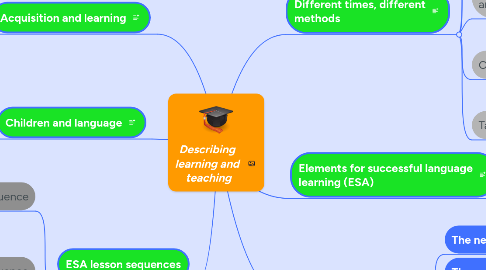
1. Acquisition and learning
1.1. Teachers should concentrate on acquisition rather than learning....
2. Children and language
2.1. Acquire a language
2.1.1. exposure to it
2.1.2. motivation to communicate
2.1.3. opportunities to use it
3. ESA lesson sequences
3.1. Straight arrows sequence
3.1.1. First the teacher gets the class interested and engaged; then they study something; then they try to activate it by putting it into production.
3.2. Boomerang sequence
3.2.1. The students are first asked to use language in an activation stage, and are then taught how to deal with things they made mistakes with before trying thetesting part of it again
3.3. Patchwork sequence
3.3.1. They are a mixture of procedures and mini-procedures, a variety of short episodes building up to a whole.
4. Different times, different methods
4.1. Grammar-translation(1780)
4.1.1. Introduced the ideal with short grammar rules and translation...
4.2. Audio-lingualism(1940
4.2.1. Describe the grammatical patterns of English and student can learnt easy...
4.3. PPP (Presentation, Practice and Production)
4.3.1. The teacher presents and explain new language..,after that student practise, making sentences,...
4.4. Communicative Language Teaching (CLT)
4.4.1. Reminded teachers that people learn languages not so that they know about them, but so that they can communicate with them....
4.5. Task-Based Learning (TBL)
4.5.1. In TBL, the emphasis is on the task rather than the language....
